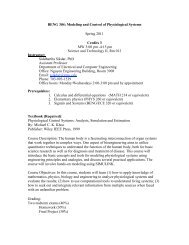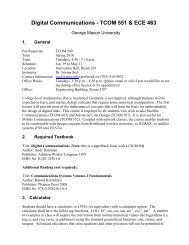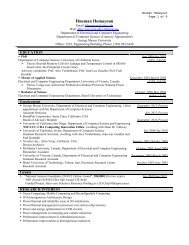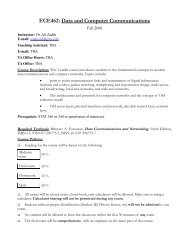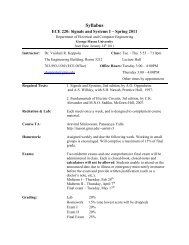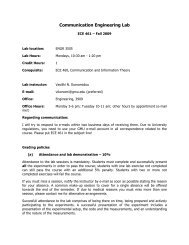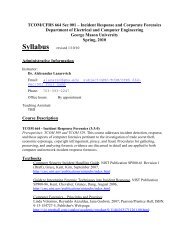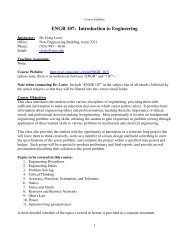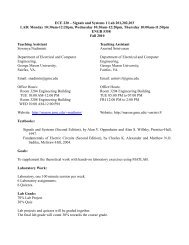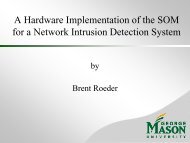ECE646 Lab 2 CrypTool – Historical Ciphers
ECE646 Lab 2 CrypTool – Historical Ciphers
ECE646 Lab 2 CrypTool – Historical Ciphers
You also want an ePaper? Increase the reach of your titles
YUMPU automatically turns print PDFs into web optimized ePapers that Google loves.
<strong>ECE646</strong><br />
<strong>Lab</strong> 2<br />
<strong>CrypTool</strong> <strong>–</strong> <strong>Historical</strong> <strong>Ciphers</strong><br />
A final report should be submitted using MyMason and is due on<br />
Saturday, October 29th, by 11:59 PM.<br />
Bonus tasks can be submitted by Saturday, November 5 th , 11:59 PM.<br />
BACKGROUND<br />
Expected Background: understanding of Lecture 5, <strong>Historical</strong> <strong>Ciphers</strong>.<br />
Recommended Reading:<br />
• W. Stallings, Cryptography and Network Security, 5 th or 4 th Edition, Chapters<br />
2.2-2.7.<br />
• A. Menezes, P. van Oorschot, and S. Vanstone, Handbook of Applied Cryptography,<br />
Chapter 7.3, Classical ciphers and historical development.<br />
• <strong>CrypTool</strong> <strong>–</strong> On-line Help<br />
o Help => Starting page => Functionality of <strong>CrypTool</strong> => Document encryption =><br />
Symmetric (classic)<br />
o Help => Starting page => Functionality of <strong>CrypTool</strong> => Analyzing Documents<br />
=> Tools for Analysis and Symmetric Encryption (classic)<br />
1. INSTALLATION<br />
In order to complete this lab you might want to install <strong>CrypTool</strong> on your personal<br />
computer/notebook. You can download Cryptool from<br />
http://www.cryptool.de/<br />
Alternatively, you may use computers located in the GMU ECE labs, The Engineering Building,<br />
rooms 3204 and 3208, which have <strong>CrypTool</strong> already installed on them.<br />
The recommended version is <strong>CrypTool</strong> 1.4.30.<br />
Task 1 (20 points)<br />
2. BREAKING AFFINE CIPHER<br />
Below please find a ciphertext obtained by encrypting a message in English using the Affine<br />
cipher.<br />
Please note that spaces and punctuation characters have been removed before encryption.<br />
The ciphertext has been divided into blocks of the size of 5 letters.<br />
HJWWL CGOUR CFMCJ FDDEB ORSOH OFLCW URCFO RAVQL WFDWH JWWLC<br />
GFCGE KWGOU FEKWU GS
Find the secret key used for encryption, by breaking the Affine cipher analytically, using method<br />
given in Lecture 5. Use <strong>CrypTool</strong> to analyze the frequency of letters in the ciphertext and<br />
recover the plaintext.<br />
Your attack must be analytical and fully documented. Brute-force attacks do not count.<br />
3. RECOGNIZING AND BREAKING CIPHERS FOR THE SAME TEXT<br />
ENCRYPTED USING DIFFERENT CIPHERS<br />
Task 4 (30 points + bonus points)<br />
Below please find 6 ciphertexts of the same message encrypted using the following<br />
6 classical ciphers available in <strong>CrypTool</strong>: Caesar (shift cipher with k=3), Vigenere, Hill (with<br />
d=3), Affine, Playfair, and Permutation. Do your best to match ciphertexts with a cipher that<br />
could have been used to obtain a given ciphertext. If you are uncertain, you can list several<br />
ciphers per each ciphertext.<br />
Find the corresponding plaintext, by breaking the Caesar cipher, and then find the keys for at<br />
least 3 ciphers used to encrypt the now known plaintext. You will obtain extra points for any<br />
additional cipher broken using known-plaintext attack. All attacks must be documented. Bruteforce<br />
attacks do not count.<br />
Please note that spaces and punctuation characters have been removed before encryption.<br />
The ciphertext has been divided into blocks of the size of 5 letters.<br />
Ciphertext 1<br />
UTAGH ZWAGR FOTSG AOKIE QOXCA QSGKA IIKRB YILWF TESZG TYLCO<br />
QRWAV ZDWRG TALHU QSLFB ZGWGG YIYVG IESYR ZAFRG TEOWF QSLAV<br />
SHLSE DMY<br />
Ciphertext 2<br />
MWKKV QABXO YSHGC IBZOK AEYWD ETILO ABXZK NMWKM MSAKV FEWOA<br />
SBCLG WJSMF RYCJN UGCPW SQETY YFXJJ CCZLK CGRVX XCJEV FKKGS<br />
VQRWY HYT<br />
Ciphertext 3<br />
UTOFW OHYED HNIAD SGMSE OOODS HRETO MENII RIWBU NWIAO IHSEH<br />
EHSTI STESS ITEDT RTWAW MRTIE REITL BNATS TNETE NOSON METMT<br />
EGGKT EHG<br />
Ciphertext 4<br />
SCANI UZNTS YETRY EENBU ORHES ONEOY ZNAFR GSCAN FOIDY FBYRY
OMOGA UFGFV DNBQY FSTBE NYEOT FICOD YQGSF RUSAH YFOQA NSTCE<br />
AMFYO MMGRP<br />
Ciphertext 5<br />
LWLVX QZLVH WREHW RRVXU HRIRQ HVRZQ ZLVGR PLWLV KHDOW KBWRE<br />
HUHPL QGHGW KDWWK HVWUR QJHVW PLJKW ZHDNH QDQGW KHZLV HVWPL<br />
JKWHU UPJ<br />
Ciphertext 6<br />
ONOGU XIOGM NERMN EEGUZ METEX MGEIX IOGFE QONOG HMKJN HWNER<br />
MZMQO XFMFN HKNNH MGNZE XAMGN QOAHN IMKCM XKXFN HMIOG MGNQO<br />
AHNMZ ZQA<br />
4. RECOGNIZING AND BREAKING CIPHERS FOR DIFFERENT TEXTS<br />
ENCRYPTED USING DIFFERENT CIPHERS<br />
Task 5 (50 points + bonus points)<br />
Below please find 6 ciphertexts of different messages encrypted using the following 6 classical<br />
ciphers available in <strong>CrypTool</strong>: Caesar (shift cipher with k=3), Vigenere, Hill (with d=3), Affine,<br />
Playfair, and Permutation. Do your best to match ciphertexts with a cipher that could have been<br />
used to obtain the given ciphertext. If you are uncertain, you can list several ciphers per each<br />
ciphertext.<br />
Break at least 2 out of 6 ciphers. You will obtain extra points for any additional cipher broken<br />
using ciphertext-only attack. All attacks must be documented. Brute-force attacks do not count.<br />
Please note that spaces and punctuation characters have been removed before encryption.<br />
The ciphertext has been divided into blocks of the size of 5 letters.<br />
Ciphertext 1<br />
KBMPT QDKZL QZKPL MFCNK GLGEX HUKYF FMPIT QDKZL QZKPL MEONX<br />
FKKUP MKPAM<br />
Ciphertext 2<br />
EDOOU RNLIO TOSHM OAOST REBEH AFIDA ODREE BSOEG ROTMT EOTEP<br />
IRTBE RUBEM AOSET BSMPP GNOUC REEDS NRNCR YOULR ANETO RCNYI<br />
Ciphertext 3<br />
WRIJC IXPCI QZRIZ QYHAE PLWZZ LCSRW LXPCV OWLLA VCXIY LWJCW<br />
VIVIZ WAVOR CPCZR CYOWL LVAZN CBEXM CXNYZ RCSAL APAHZ RCWPU<br />
GWVNE ZNYZR CSAVZ CVZAH ZRCWP SRIPI SZCPQ LG
Ciphertext 4<br />
TNFRC KZLVY HWYRD DAXAL LWZRW LVBJM XZYBV EBWLX IRGYH BNQGM<br />
IZLVJ BCGKP TYDRS XHHAG QEXDO XZUFF AZPKW VIEZJ BHIU EO<br />
Ciphertext 5<br />
XINKR NCWEI RRKER EGBIF AIHRM MFEOH JIEQP RRGEO FLFYS KEXGV<br />
OYPRI MTEFB IXHKS BMMEZ UAZSN GNQVE SZEEE IUXOC VMFEO HJIEQ<br />
LVSIR GLVQE TOOAT SMKHR IITUT UZWGG TRDVG URORG HKVBG INZHV<br />
JKAZE ZIKOX BNTLE BMEXS RHAPY IVZEN IHOCN GYMSC AYCVR<br />
Ciphertext 6<br />
BRXPX VWEHW KHFKD QJHBR XZDQW WRVHH LQWKH ZRUOGPJ<br />
Task 6 (Bonus 30 points)<br />
5. BREAKING THE VIGENERE CIPHER (BONUS)<br />
Below is the ciphertext of a message encrypted using Vigenere cipher. Using a combination of<br />
the Kasiski’s method, and the Method of Index of Coincidence determine a period of the<br />
Vigenere cipher, d. Then, write the ciphertext in the form of a rectangle matrix with d columns,<br />
and break a shift cipher applied to each column individually. Determine the full message.<br />
Document in detail all steps of your codebreaking process.<br />
PLMQX GYDKO UMUVB TVGKI UMEVX BHJXI VXETJ UERXA HEWHB RGWJF<br />
ZDVVP IPHVI ETPWV SAIZY SSLRD ZDVVQ WCKXX VJWLK DTFKX MDGVJ<br />
CALXT HFWEG GWHME PITTC RNXCH EOQQA WLTII HRGQJ MOMVR QESLC<br />
VMSQW SOJHQ PORPI KKGHH TUSRZ SRLHN OYZNI AFIDR GKISQ PEVAL<br />
RIMAJ ILUOX SBIEW SVIGK IEOED LTHEE PTFGX BVRFL MAHVD YFIMA<br />
CRVPE OWWAP FRMIB QOSCA GIGWG DRQKR ZVRRY TAAIT MPOGA JFVFS<br />
XWGRV RESGX YHVVS ECOLB HRFWQ GRVNM AWIKC WGLAP IZTCF AGLOE<br />
WEWAD XWIFH XGNIF LRWMP OEKAB TWFZJ NGWSN SHBSH YMESM QJQCM<br />
KHXXF RGNLR QXDJG KINDS OLQRW VDETR XBZLO XABRR PWGKI BWXUY<br />
IDOQQ WRRPQ HUHMM HQMII QVXNV ILVJD QGCIT ABAQR FYIVQ ECHNG<br />
HGJIL BKJIU EIFNM POGVJ AURYA HBQLV USPUM QMVTA KIOMW AJNBR<br />
MEEEA WSVOQ XKMDX GLDYE KMBPS FVQDX ILRVE ZGXBT IPIFT AKEUM<br />
HJSJV WDTPR NQHBW VLLPY IUALV ALMQN ZQBUH TGIFL HRPXL HXWIP<br />
EIFNM WHUSK IPWXW EGWLR TYMOP HWUPM GLHGA RBYWS RYGWH EQNTM<br />
GLWQS YZFWE KAHUS UZBVT TGGRJ PQQIL POMPR EEGEI BQWSI SHABS<br />
AWLFV SFHOH TGLCV ZBUAR FRIAQ



